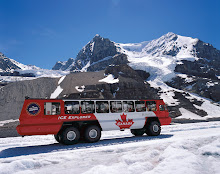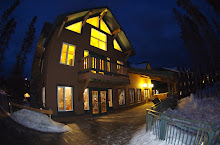
Not many people know that your activities in the Canadian Rockies don't all have to be out in the open. Canmore is home to the Rat's Nest Cave and Canmore Cavern's runs tours into this amazing cave system.
No experience is necessary and they kit you out with coveralls, helmet and headlamp and a certified guide to make sure that you have a safe and fun experience.
There are two options; the Adventure Tour involves a 60 foot rappel along with the climbing, crawling, squeezing, grunting, and groaning that goes along with the Explorer Tour.
I did the Explorer Tour - mostly because it was less $$ than the Adventure Tour - and loved every second of it.
We met our guide and followed her to the cave entrance where we put on our kneepads, coveralls, helmets and headlamps and strapped on our safety harnesses. The adventure started off with a slide down the smoothest rock surface I've ever encountered. Think the slide at your local playground, that's how smooth it was.
Within seconds it became apparent how important it was to have a guide with you. She lead us away from the 60 foot drop and towards what looked to me to be a solid wall of rock. That is until the guide hunkered down on her hands and knees and disappeared under an outcrop.
Being in a cave is amazing. My sense of equilibrium was way off as my peripheral vision ended where my headlamp light stopped. You have no horizon to orient yourself with and the floor of the cave is pitched in every which way but level. The crab walk was the preferred method of motion for my friends and I.
Through tunnels and down slopes we scrambled and crawled until we were 55 meters below the trail that we hiked up to the cave entrance on. The cave is always at 5 C and there is only a small amount of humidity. Just enough to dampen the knees and bum of your coveralls. After we tried out our spelunking skills with a few tight spots (arms up or down - not under because now you're wedged!) we started back towards the entrance.
I have a really good sense of direction, but in that cave I was totally lost. We got to a spot called the 5 way cavern and I had no idea which way to go, never mind which way I had just come from. Guide to the rescue once more! The exit is right where your knee is!
The most challenging part of our caving adventure was the same smooth as glass piece of rock that we had slid down to get into the cave. What goes up, must come down - or rather, what goes down, must come up! I'm not very flexible at the best of times so I cannot explain how in the world I managed to get my knee into a gripping point that was up by my shoulder. The day after I sure felt it though!
Canmore is an hour’s drive from Lake Louise and if you’re not into driving that far for a day trip, you can choose to stay at the ACC Clubhouse (an HI affiliate hostel) in Canmore, or at the HI-Banff Alpine Centre.
Rates for Canmore Caverns’ excisions start at $99/person and they offer a range of different spelunking activities.
No experience is necessary and they kit you out with coveralls, helmet and headlamp and a certified guide to make sure that you have a safe and fun experience.
There are two options; the Adventure Tour involves a 60 foot rappel along with the climbing, crawling, squeezing, grunting, and groaning that goes along with the Explorer Tour.
I did the Explorer Tour - mostly because it was less $$ than the Adventure Tour - and loved every second of it.
We met our guide and followed her to the cave entrance where we put on our kneepads, coveralls, helmets and headlamps and strapped on our safety harnesses. The adventure started off with a slide down the smoothest rock surface I've ever encountered. Think the slide at your local playground, that's how smooth it was.
Within seconds it became apparent how important it was to have a guide with you. She lead us away from the 60 foot drop and towards what looked to me to be a solid wall of rock. That is until the guide hunkered down on her hands and knees and disappeared under an outcrop.
Being in a cave is amazing. My sense of equilibrium was way off as my peripheral vision ended where my headlamp light stopped. You have no horizon to orient yourself with and the floor of the cave is pitched in every which way but level. The crab walk was the preferred method of motion for my friends and I.
Through tunnels and down slopes we scrambled and crawled until we were 55 meters below the trail that we hiked up to the cave entrance on. The cave is always at 5 C and there is only a small amount of humidity. Just enough to dampen the knees and bum of your coveralls. After we tried out our spelunking skills with a few tight spots (arms up or down - not under because now you're wedged!) we started back towards the entrance.
I have a really good sense of direction, but in that cave I was totally lost. We got to a spot called the 5 way cavern and I had no idea which way to go, never mind which way I had just come from. Guide to the rescue once more! The exit is right where your knee is!
The most challenging part of our caving adventure was the same smooth as glass piece of rock that we had slid down to get into the cave. What goes up, must come down - or rather, what goes down, must come up! I'm not very flexible at the best of times so I cannot explain how in the world I managed to get my knee into a gripping point that was up by my shoulder. The day after I sure felt it though!
Canmore is an hour’s drive from Lake Louise and if you’re not into driving that far for a day trip, you can choose to stay at the ACC Clubhouse (an HI affiliate hostel) in Canmore, or at the HI-Banff Alpine Centre.
Rates for Canmore Caverns’ excisions start at $99/person and they offer a range of different spelunking activities.































